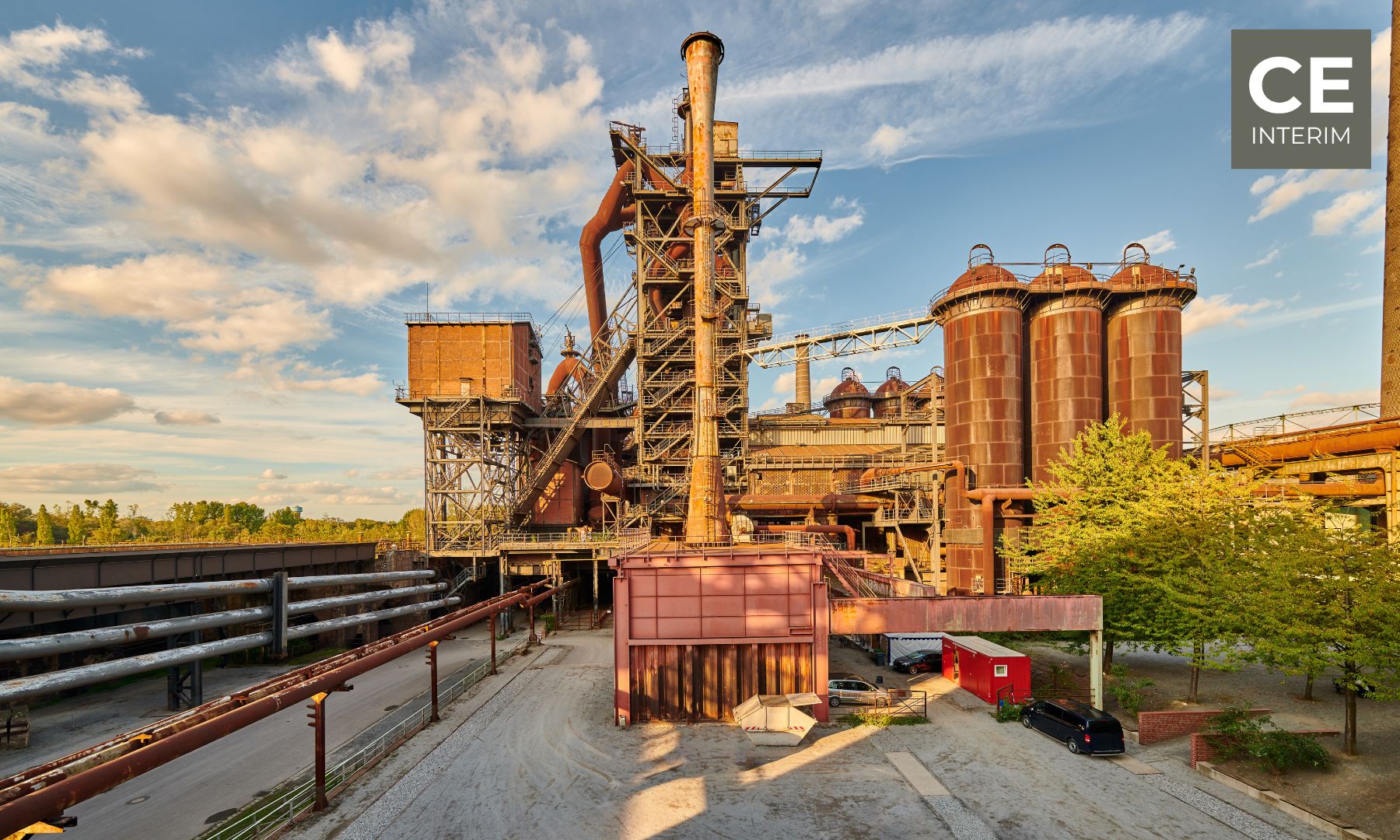¿No tiene tiempo para leer el artículo completo? Escuche el resumen en 2 minutos.
Alemaniasímbolo del poderío industrial, se enfrenta ahora a un cambio alarmante: las industrias se están trasladando al extranjero, en gran parte debido a la subida vertiginosa de los costes energéticos. Esta tendencia creciente de "La desindustrialización en Alemania". está sacudiendo la economía del país y remodelando el panorama industrial mundial, dejando preocupadas a innumerables empresas.
Los altos precios de la energía, impulsados La crisis energética está obligando a las empresas, sobre todo a las de las industrias de alto consumo energético, a mirar hacia el futuro. en otro lugarlo que provocará la pérdida de puestos de trabajo y un descenso de la producción manufacturera. La UE está tremendamente preocupada por la situación.
Pero, ¿cómo ¿Cuál es el camino a seguir para su valioso sector industrial? Aquí se lo explicamos.
Un rápido vistazo a la antigua fuerza industrial de Alemania
El sector industrial alemán ha sido la columna vertebral de su economía durante décadas. Desde la reconstrucción posterior a la Segunda Guerra Mundial hasta convertirse en uno de los principales centros manufactureros mundiales, el país ha sido el espacio preferido para industrias como la automovilística, la química, la siderúrgica y la maquinaria.
Históricamente, el uso eficiente de la energía y la solidez de las infraestructuras dieron a Alemania una ventaja competitiva en el mercado mundial, lo que la convirtió en un ejemplo a seguir para muchos. Sin embargo, las cosas han empeorado bastante desde entonces.
El giro de Alemania hacia las energías renovables, comúnmente denominado "EnergiewendeLa "transición a la energía limpia" provocó problemas imprevistos. A pesar de su noble objetivo de transición a una energía limpia, la estrategia pasó por alto las demandas energéticas inmediatas de las industrias pesadas, que dependen de fuentes de energía asequibles y estables.
En consecuencia, el aumento de los elevados precios de la energía en Alemania empezó a roer su núcleo industrial, desencadenando la desalentadora tendencia de desindustrialización en Alemania.
¿Qué desencadenó la crisis energética en Alemania?
La crisis energética de Alemania no tiene un único culpable. Más bien se ha desencadenado por una mezcla de factores como el bloqueo del gas natural económico procedente de Rusia y los estrictos intentos de transición hacia las energías renovables.
Durante años, la estrategia energética de Alemania ha dependido en gran medida de las importaciones de gas procedentes de Rusia. Sin embargo, las recientes tensiones geopolíticas y la guerra de Ucrania han perturbado gravemente el suministro. Esto provocó una subida de los precios del gas en Europa y Alemania se convirtió en la principal víctima del agotamiento.
Además, el país también se ha comprometido a eliminar progresivamente el carbón y la energía nuclear mientras realiza la transición a fuentes renovables como la eólica y la solar, lo que provoca volatilidad en el suministro. Estas fuentes aún no son lo bastante fiables como para cubrir por completo las enormes necesidades industriales del país.
Como consecuencia, los precios del gas se han multiplicado por más de tres antes de la crisis en Europa. Gigantes industriales alemanes como BASF y Thyssenkrupp luchan ahora contra la escalada de gastos y abogan por opciones como las industrias de alto consumo energético reubicación.
El impacto de los altos precios de la energía en las industrias de alto consumo energético
El sector industrial alemán está dominado por industrias que consumen mucha energía, como la fabricación de automóviles, acero, aluminio y productos químicos. Estas industrias necesitan enormes cantidades de energía para funcionar sin problemas y la situación reciente las ha dejado vulnerables. Qué sectores son los más afectados?
Por ejemplo, BASFun gigante mundial de la química, anunció recientemente planes para reducir sus operaciones en el país, con el motivo de los insoportables altos precios de la energía en Alemania. Ahora, la empresa está centrando sus esfuerzos en ampliar su producción en China y Estados Unidos para acceder a unos costes energéticos más estables.
La principal potencia de Alemania, la industria automovilística, también está pasando apuros debido a la inmensa presión causada por el aumento de los costes energéticos. Un estudio reciente reveló que los costes de la energía para el sector automovilístico alemán aumentaron en 20% en 2022 y una tendencia similar en 2023.
Para hacer frente a la situación, algunas empresas están invirtiendo en eficiencia energética en la fabricación, mientras que otras buscan productos más baratos. alternativas. La creciente tendencia a la deslocalización industrial debido a los costes energéticos está socavando la posición de Alemania como potencia industrial.
Deslocalización industrial de Alemania a los PECO
Con los precios de la energía abrazando la insostenibilidad, las grandes empresas (incluso las industrias) están producción en movimiento a regiones con opciones energéticas más asequibles. CEE (Europa Central y Oriental), Región de los BalcanesEstados Unidos y algunas zonas de Asia (incluida China) se han convertido en destinos populares.
¿Por qué se trasladan las empresas alemanas a los PECO?
Países de Europa Central y Oriental como Polonia, Hungría y la República Checa ofrecen precios energéticos más bajos, mano de obra cualificada y proximidad a Alemania. Estos factores los convierten en un destino atractivo para que los fabricantes alemanes trasladen sus plantas y escapen al aumento de los costes energéticos. Estos países "sirvieron" durante décadas a la industria alemana como base de operaciones, banco de trabajo de fabricación y albergan una enorme infraestructura. Por tanto, la deslocalización a la región de Europa Central y Oriental no es un escenario desconocido para las empresas alemanas. ¿Qué hay que hacer y qué no hay que hacer para tener éxito? Traslado de fábricas?
¿Por qué Estados Unidos es otro gran destino para los fabricantes alemanes?
EE.UU. también se ha convertido en un lugar de reubicación preferido por las empresas con un uso intensivo de energía debido a la abundancia de gas natural y a un suministro energético más estable. Por ejemplo, BASF anunció recientemente importantes inversiones en sus operaciones estadounidenses para mitigar el impacto de la crisis energética alemana.
Mientras las industrias se trasladan al extranjero, la economía alemana se enfrenta a graves consecuencias, como el aumento del desempleo, la pérdida de moral de los trabajadores y conocimientos técnicos, y una reducción de la producción manufacturera. Los expertos creen que cuanto más tiempo dependa Alemania de sus actuales estrategias energéticas sin reforzamientos, mayor será la amenaza para su industria a largo plazo. futuro.
¿Cuáles son las soluciones energéticas sostenibles para las industrias alemanas en plena crisis?
La deslocalización industrial debido a los costes energéticos sigue siendo una preocupación creciente para la economía alemana, mientras que los expertos han ideado ciertas soluciones que podrían ayudar al país a proteger su poderío industrial. Veamos algunas soluciones clave:
1. Inversión en hidrógeno verde: El hidrógeno verde ha surgido como una solución prometedora para las industrias que requieren grandes cantidades de energía. El uso de energías renovables para producir hidrógeno permitirá a Alemania ofrecer una alternativa sostenible a los combustibles fósiles y reducir su dependencia del gas natural.
2. Tecnologías de almacenamiento de energía: Los sistemas eficientes de almacenamiento de energía, como las baterías avanzadas y las centrales termosolares, pueden desempeñar un papel vital en la estabilización del suministro energético durante la transición, especialmente cuando la producción de energías renovables es baja.
3. Fabricación de vehículos eléctricos a partir de combustibles fósiles: El sector de los vehículos eléctricos (VE) ha dado un rayo de esperanza a la economía alemana. La producción automovilística del país, impulsada por los fabricantes de VE que abrazan la transición ecológica, aumentará en 11% en 2023.
4. Incentivos y ayudas gubernamentales: El gobierno alemán ha anunciado varias subvenciones e iniciativas para apoyar a las industrias de soluciones energéticas sostenibles, como exenciones fiscales para las empresas que inviertan en eficiencia energética en la fabricación e integración de energías renovables. El objetivo es reducir los costes energéticos de los fabricantes.
¿Cuál es el impacto global de la desindustrialización en Alemania?
La cadena de suministro mundial también está sintiendo el impacto de los problemas industriales de Alemania debido al aumento de los costes energéticos y la inestabilidad de su disponibilidad. Los países que reciben deslocalizaciones industriales alemanas se benefician de mayores inversiones, mientras Alemania lucha por mantener su dominio industrial.
Además, la subida de los precios del gas en Europa ha provocado un cambio en los mercados mundiales de la energía, en los que las empresas se centran en suministros energéticos más estables. El efecto dominó de la desindustrialización de Alemania puede llevar a una reorganización de los centros mundiales de fabricación, lo que podría alterar la dinámica competitiva en todos los sectores.
Última palabra
La subida de los precios de la energía y la actual crisis energética están empujando a las industrias al extranjero, lo que está provocando la aceleración de la desindustrialización en Alemania. Las industrias alemanas deben combatir la situación a tiempo con la pronta adopción de soluciones energéticas sostenibles, mientras que los responsables políticos deben ofrecer el apoyo tan necesario para evitar una mayor erosión de la base manufacturera del país.
A pesar del aumento de los costes y de la elevada inflación de los últimos años, Europa Central y Oriental sigue ofreciendo un paraíso seguro en la Unión Europea, con una infraestructura viaria bien construida.
Comprender las causas y consecuencias de la deslocalización industrial es crucial no sólo para Alemania, sino para las industrias de todo el mundo. La deslocalización industrial sigue siendo una opción viable para que las empresas disfruten de ventajas en costes y estabilidad.
La creciente tendencia a la deslocalización de fábricas a Europa Central y Oriental, o a la región de los Balcanes, puede dejar hueca la economía alemana, pero hágase una pregunta sincera: "¿Cuál es la alternativa?", "¿Qué parte de la industria alemana puede sobrevivir/sobrevivirá los próximos 12 meses en Alemania?".
El antiguo gigante manufacturero debe recuperar su trono. Para ello es imprescindible equilibrar los objetivos de transición energética con las necesidades económicas de su sector industrial y la moral de los trabajadores.
¿Se enfrenta a retos empresariales complejos y no sabe cuál es el siguiente paso? Los expertos y gestores interinos de CE Interim están aquí para guiarle.
Desde el traslado de fábricas hasta la excelencia operativa y la optimización de la cadena de suministro, ofrecemos soluciones personalizadas diseñadas para mantener su negocio en marcha y prosperando. Con nuestra experiencia demostrada, garantizamos transiciones fluidas y un crecimiento sostenible.
Póngase en contacto con nosotros para hablar de cómo podemos contribuir a su éxito.





